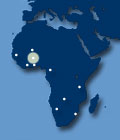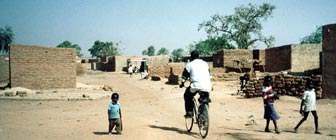|
||||||||||||
| Burkina Faso | Cameroon | Cote D’Ivoire | Ghana | Mali | Namibia | Tanzania | Senegal | Swaziland | Zambia | ||||||||||||
Information Source: Burkina Faso: Country Assessment Report. |
||||||||||||
|
||||||||||||
|
Context Summary One of the poorest countries in the world, landlocked Burkina Faso has a high population density, few natural resources, and a fragile soil.. About 90% of the population is engaged in mainly subsistence agriculture. With a population of 11.6 million, 18% were urban in 1999. It ranks 172 out of 174 in the Urban Development Index. One of the first urban upgrading projects in all of the West Africa Region was started in 1974 in Bukina Faso by UNDP and UN-Habitat. Between 1983 and 1990, the Government implemented a massive national urban upgrading program during which more than 125,000 plots were regularized. However, these ‘lotissements’ were generally not accompanied by investment in adequate infrastructure. New donor projects are largely focused on providing these services, with additional focus on community participation. Most peri-urban areas possess regular plots in a grid pattern, except for the most recent, as a result of the national ‘lotissement’ policy of the 1980s. An average of 22% of the capital Ouagadougou is connected to water: 49.7% in the center and 0.5% in the informal settlements. The majority have only access to latrines. Most roads are unpaved. Lessons from Recent Projects - Summary Regularized and Legalized Land Policy
Service Delivery
Community Participation
Social Intermediation Team
Limits of the Demand-Responsive Approach Project
|
||||||||||||
|
|
||||||||||||
| For more information: Click on: Foreword and Introduction to Assessment 1. Problems and Context 2. Current Situation 3. Policy Context and Institutional Framework 4. Upgrading Projects and Programs 5. Case Study: Third Urban Environment Project 6. Lessons Learned 7. Challenges and Proposed Next Steps Annex A: Country and City Profiles Annex B: Bibliography Annex C: Contact Information Annex D: Photographs Annex E: Abbreviations and Acronyms Download for Printing: |
||||||||||||
| < Return to top > | ||||||||||||
|
||||||||||||


